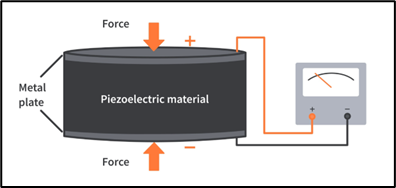Why in News?
- A pair of chemists at Michigan State University has observed the piezoelectric effect in liquids for the first time.
- In their paper published in The Journal of Physical Chemistry Letters, Iqbal Hossain and G. J. Blanchard, describe accidently observing the property while studying ionic liquids.
What’s in today’s article?
- About Piezoelectric Effect (Concept, History, Materials, Applications, etc.)
- Discovery of Piezoelectric Effect in Liquids (About the Research, Significance)
What is the Piezoelectric Effect?

- The piezoelectric effect is a phenomenon where specific types of material (e.g., quartz, topaz, etc.) produce an electric charge proportional to the mechanical stress applied to them.
- It occurs when there is a conversion of kinetic or mechanical energy due to crystal deformation, into electrical energy.
- Piezoelectric materials are materials that can produce electricity due to mechanical stress.
- When a piezoelectric material is placed under mechanical stress, there is a shift of the positive and negative charge centres in the material, which then results in an external electric field.
What is the History behind the Piezoelectric Effect?
- In 1880, Jacques and Pierre Curie discovered that pressure generates electrical charges in certain types of crystals such as quartz and tourmaline.
- They called this phenomenon the "piezoelectric effect". The word "piezo" is derived from the Greek word piezein, which means to squeeze or press.
- Later they noticed that electric fields can deform piezoelectric materials. This effect is called the "inverse piezoelectric effect".
- After these first demonstrations, more work was undertaken to explore the great potential of the piezoelectric effect.
About Piezoelectric Materials:
- A crystal is any solid with atoms or molecules that are arranged in a very orderly way based on repetitions of the same basic atomic building block (the unit cell).
- In most crystals (such as in metals), the unit cell is symmetrical; in piezoelectric crystals, it is not.
- Normally, piezoelectric crystals are electrically neutral.
- The atom arrangement may not be symmetrical, but the electrical charges are perfectly balanced: a positive charge in one place cancels out a negative charge nearby.
- However, stretching or squeezing a piezoelectric crystal deforms the structure, pushing some of the atoms closer together or further apart.
- This upsets the balance of positive and negative, and causes net electrical charges to appear.
Examples of Piezoelectric Materials:
- There are a variety of piezoelectric materials, both man-made and natural, that can produce electricity.
- Natural –
- The most well-known, and the first commercially available piezoelectric material used in electronic devices is the quartz crystal.
- Other naturally-occurring piezoelectric materials include topaz, tourmaline, and even bone.
- Man-made –
- A breakthrough came when scientists developed a new class of man-made materials, called ferroelectrics, which exhibited piezoelectric characteristics many times more powerful than piezoelectric crystals.
- Scientists kept searching for higher performance materials and this resulted in the development of barium titanate and lead zirconate titanate.
Applications of Piezoelectric Effect:
- Developed in the 1900s to detect icebergs, the sonar device is the first practical application for piezoelectric devices.
- Sensors, high voltage generators, electronic frequency generators, microbalances, inkjet printers, and ultra-fine focusing and alignment of optical assemblies among others all exploit piezoelectric technology.
- It is also the basis of a number of scientific instrumental techniques with atomic resolution, such as scanning tunnelling microscopes.
Discovery of Piezoelectric Effect in Liquids:
- The researchers at Michigan State University were studying properties of ionic liquids.
- Ionic liquids are made from salts with unsymmetrical, flexible organic cations and symmetrical weakly coordinating anions.
- The liquid piezoelectric material was discovered as the researchers applied pressure with a piston to a sample of an ionic liquid in a cylinder.
- To their surprise, they found that this led to the release of electricity.
- They also found that the amount of electricity released was proportional to the amount of pressure applied.
What is the Significance of this Discovery?
- The reason the piezoelectric effect has only been expected in solids thus far is that the body being squeezed needs to have an organised structure, like the pyramids of quartz.
- Liquids do not have such structure; instead, they take the shape of their container.
- The researchers suggest that liquid piezoelectric materials could prove to be useful, especially ones made using ionic liquids, because they would be more environmentally friendly than solid materials.
- They also note that liquid piezoelectric materials could allow more variety in device shape, opening up wider design opportunities.









